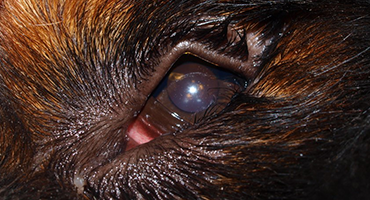Entropion in dogs
Overview
- Entropion is a condition that causes the eyelid(s) to roll inwards and rub the surface of the eye.
- It’s a painful problem that often leads to inflammation, infections and ulcers, which left untreated, can cause scarring, blindness and in severe cases, loss of an eye.
- Entropion is most common in dogs with short noses and/or excess skin around their eyes and nose.
- Most dogs with entropion require surgery to evert their eyelid(s).
What is entropion?
Entropion is a condition that causes the eyelids to roll inwards and rub the front of the eye. It tends to affect both eyes, and although it’s more common in the lower eyelids, can affect both upper and lower lids. Left untreated, entropion can cause severe pain, inflammation, eye ulcers, infections, scarring and even loss of an eye.
Entropion can develop for many reasons, including:
Genetics/face shape/breed
- Certain pedigree dogs are more likely to suffer from entropion because of excessive skin around their eyes and nose. Breeds most affected include the Shar Pei, Chow-Chow, St Bernard, Bulldog, and Pug.
Pain
- Painful eyes often sink back into the eye socket, which in turn, can cause the eyelids to turn inwards.
- Skin problems, especially chronic problems can sometimes cause thickening of the skin around the eyes and lead to entropion. It’s important to get skin problems under control before they get severe enough to cause complications such as entropion.
Age
- Dogs can develop saggy skin with age, just like us! Saggy eyelids are likely to roll inwards. Age related entropion is very common in Cocker Spaniels.
- Occasionally, weight loss can lead to saggy skin around the eyes and entropion.
Eyelid injuries
- Injuries, surgery and any other type of damage to the eyelid can occasionally cause entropion.

Symptoms
- Weepy eye(s)
- Closing eye(s)
- Red eye(s)
- Rubbing face
- Frequent bouts of conjunctivitis
- Recurring eye infections
- Frequent eye ulcers

This dog has lower eyelid entropion – image thanks to ‘Eye Veterinary Clinic’.
Treatment
Surgery
Dogs with entropion nearly always require an operation to correct their eyelids. The procedure involves removing skin from above or below the eyelid to evert it and stop it turning inwards. This is usually a straightforward operation, but sometimes needs to be repeated more than once to cure the problem completely. If your dog is still young and growing, there is chance their entropion will improve with age, so your vet may suggest a temporary ‘tacking’ procedure to hold the eyelids in a more natural position until they are 5-12 months old.
Eye drops
It’s likely that your dog will require eye drops, before, during and after their surgery especially if they have developed any complications such as inflammation, or infection. Eye drops might include:
- Lubricating eye drops/false tears - to keep the front of the eyes moist while they heal
- Antibiotic eye drops - if your dog has an eye infection
- Anti-inflammatory eye drops - to help with pain and inflammation
If your dog requires more than one eye drop, you may find our medicine planner useful.
 Video found at youtu.be/VZHtrertQNY
Video found at youtu.be/VZHtrertQNY
Pain relief
It’s likely that your dog will be prescribed some pain relief to help reduce their discomfort before and after surgery.
Published: June 2021
Did you find this page useful?
Tell us more
Please note, our vets and nurses are unable to respond to questions via this form. If you are concerned about your pet’s health, please contact your vet directly.
Thank you for your feedback
Want to hear more about PDSA and get pet care tips from our vet experts?
Sign up to our e-newsletter
Written by vets and vet nurses. This advice is for UK pets only. Illustrations by Samantha Elmhurst.

